Surrogacy of the Red Army during the Great Patriotic War
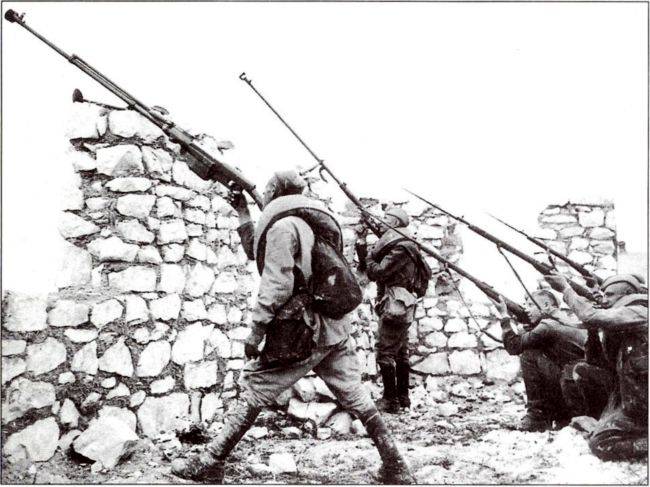
In the initial period of the war, our fighter aviation suffered heavy losses, and often could not cover the Soviet troops on the front line and in the frontline. Taking advantage of this, German fighter-bombers, dive-bombers and attack aircraft inflicted heavy losses on Soviet troops and refugee convoys. Especially from the raids the infantry units on the march, the trains on the hauls and transport convoys suffered greatly. The situation was aggravated by the acute shortage of anti-aircraft weapons intended for direct cover of troops. The pre-war Soviet industry did not manage to fully equip the troops with the necessary anti-aircraft weapons, as of 22.06.1941, air defense units of the regiment and division were equipped with only 61% anti-aircraft machine guns. For the most part, the troops had rifle-caliber installations based on the Maxim machine gun. The proportion of heavy 12,7 mm machine guns at the beginning of the war was very small.
In 1941, the main military air defense device was the quadruple 7,62-mm anti-aircraft machine gun installation M4 arr. 1931 The installation consisted of four Maxim machine gun arr. 1910 / 30 g, mounted on a zenith machine in the same plane. For better cooling of machine-gun barrels with intensive shooting, a device of forced circulation of water was used. With good fire density, the M4 anti-aircraft gun was too heavy. Its weight in the fighting position with the system of forced water cooling and a welded frame for installation in the car body reached 400 kg.
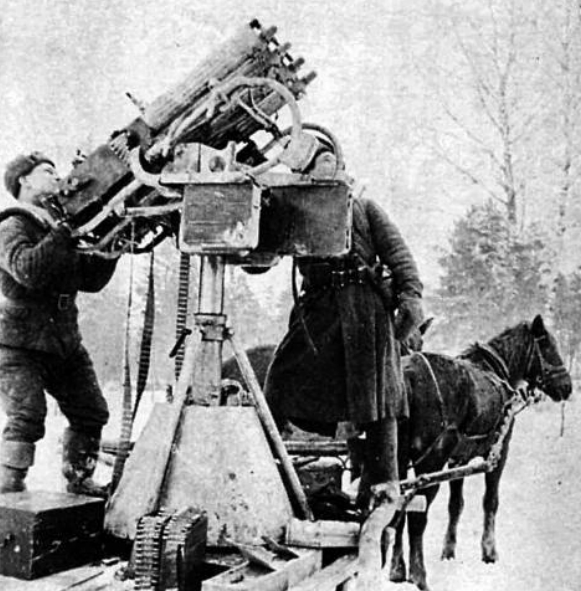
The quad installation, as a rule, was installed on cargo lorries, on railway platforms and even in horse-drawn sledges. In February, 1943, 7,62-mm machine gun installations, as outdated, were removed from the anti-aircraft regiments and anti-aircraft divisions of the Reserve of the High Command. They were replaced by more efficient 12,7-mm large-caliber machine guns, but on the secondary areas of the front, the surviving M4 was used until the end of hostilities. During the entire war, the Zenith Maxims were part of the machine-gun platoons on anti-aircraft armored trains and were installed on anti-aircraft platforms covering the echelons and individual stations.
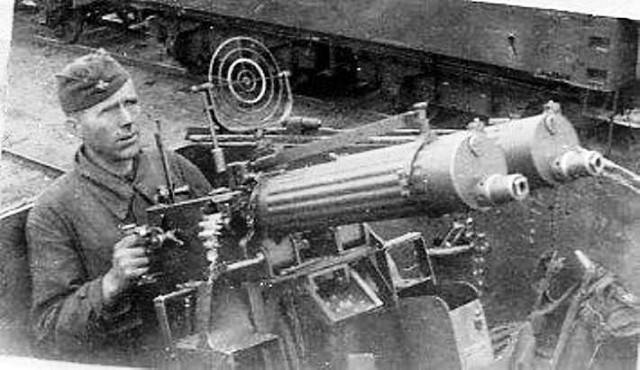
In addition to quadruple installations, in smaller quantities at the beginning of the war, the troops had a paired arr. 1930 g and single anti-aircraft installations arr. 1928 d. Maxim infantry machine guns were also used to create them. They all had water cooling, and the rate of fire of 600 shots / min on one barrel. The tabular range of destruction of air targets was 1500 m. In practice, the effective firing range of the aircraft did not exceed 800 m. Quite often, Maxim's machine guns on anti-aircraft machines were forced on the front lines to repel enemy infantry attacks. In this case, for the shooting they used rack-mount sights for infantry machine guns.
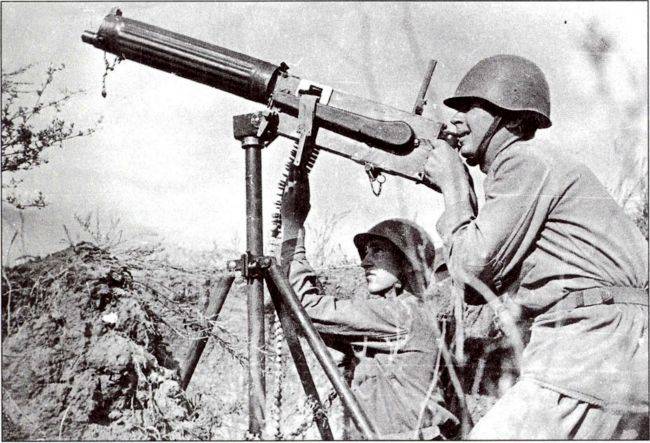
A common drawback of anti-aircraft guns based on the Maxim machine gun was an excessive weight and an unacceptably long transfer time from marching to combat position. Before repelling enemy aviation, it was necessary to fill the cover with water, otherwise the barrel would quickly overheat and the machine gun could not fire.
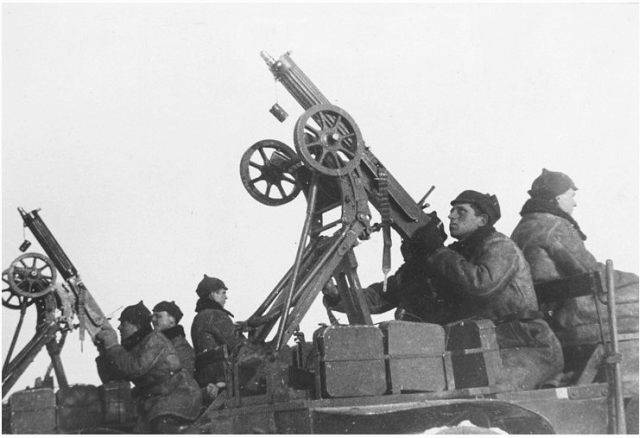
In 30-s for cavalry units produced a special anti-aircraft machine, mounted on a machine gun tachanka. The disadvantage of this machine was the limitations of the possible sector of anti-aircraft fire. In this connection, cavalrymen needed anti-aircraft machine guns with a roundabout for covering up from air strikes. But since the quadruple M4 was excessively heavy and cumbersome, they installed paired installations on the cart. 1930
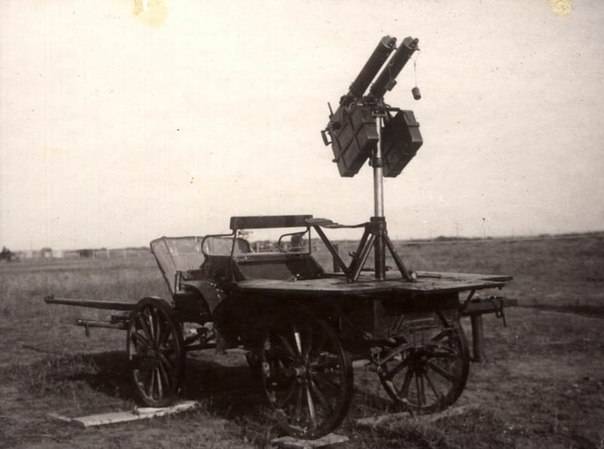
For shooting at the air enemy at the front were used Maxim machine guns arr. 1910 / 30, on the universal tripod-wheel machine system S.V. Vladimirova arr. 1931, which allowed firing, both ground and air targets.
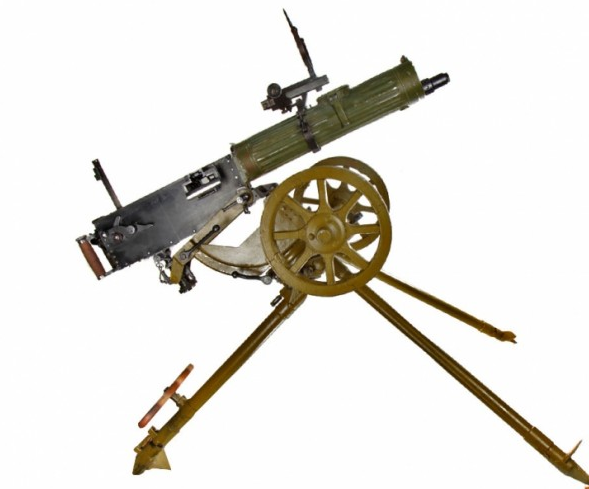
The machine gun was equipped with a ring-mounted anti-aircraft sight that allowed firing at airplanes flying at speeds up to 320 km / h at altitudes up to 1500 m. However, at its advanced installation, as a rule, they did not bother and fired at the aircraft with a standard rack mount sight, which of course reduced the effectiveness anti-aircraft fire. However, the mass production of machine guns on the universal machine began only in 1939 year. Due to the high complexity of the machines, Vladimirova did not release much. For this reason, their troops were several times smaller than the machine guns on the AA wheeled machine. Sokolova arr. 1910. However, Maxim's machine guns on the universal machine were used throughout the war.
In order to at least somehow cover themselves from air strikes, improvised anti-aircraft installations were created in the troops. Most often for this purpose they used Maxim machine guns mounted on handicraft swivels or just cart wheels with an axis dug into the ground.
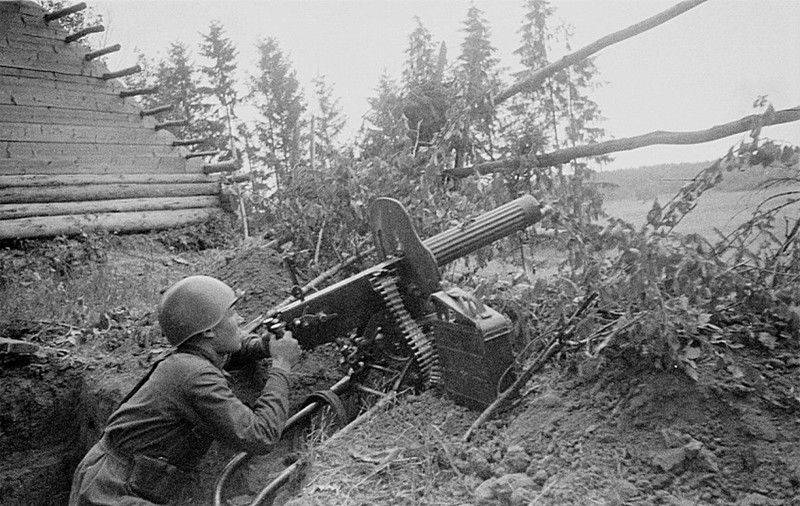
Directly at the forefront to increase the angle of elevation of the machine gun on the wheel machine, special cells were torn off, in which the trunk for towing was located at an angle up to 45 degrees, and bags with ground were placed under the wheels.
Quite often, the fire on enemy aviation was conducted from the DP-27 light machine guns. As a support, usually used forks of trees, fences, low walls, car body or carts. In extreme cases, it was possible to shoot, leaning on the shoulder of the second number of calculation. Before the war, an anti-aircraft swivel tripod was tested for the DP-27, but it was not accepted for service.
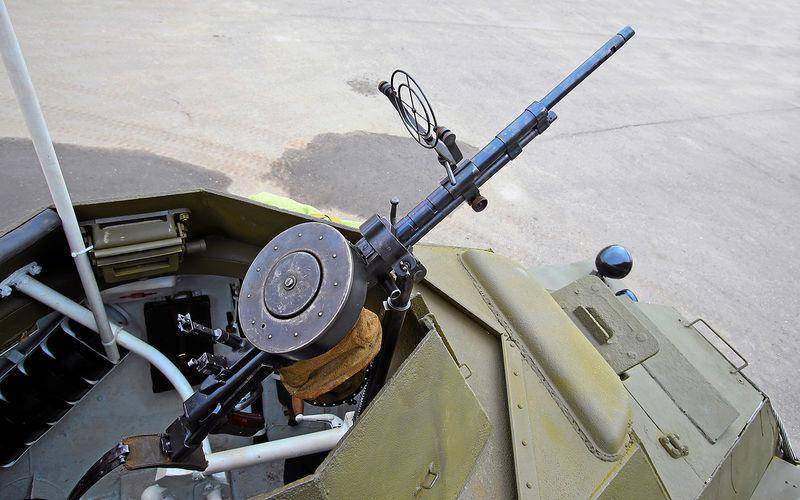
In the initial period of the war, part of the Soviet armored vehicles was equipped with P-40 anti-aircraft turrets with DT-29 machine guns. Tank the option was created taking into account the installation of a machine gun in a tight fighting compartment. Instead of a wooden butt, there was a retractable metal butt. A casing designed to protect the shooter's hands from burns on the barrel was dismantled from the DT-29 machine gun, this made it possible to reduce the dimensions and improve cooling.
According to regulatory documents, one combat vehicle in a tank or armored car company should have been equipped with an additional anti-aircraft machine gun. The first anti-aircraft turrets on the T-26 tanks were tested during the fighting in Spain. Because of the convenience of installation and the simplicity of the design of the P-40 turret, they became quite widespread. They were also installed on armored trains, armored cars, motorcycles and off-road vehicles GAZ-64 and GAZ-67. Compared to the YES-27, the anti-aircraft fire from the DT-29 turret version was higher, which was due to better stability, the possibility of round-up fire, a more capacious disk on the 63 cartridge and the presence of a special anti-aircraft ring sight. Not the last role was played by the best training of tankmen in firing on planes.
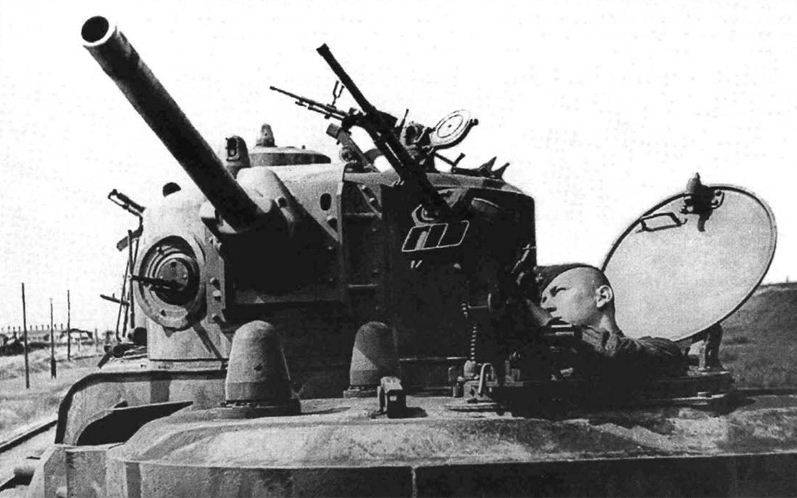
In the autumn of 1941 of the year, a quadruple anti-aircraft installation of DT-29 machine guns was experimentally created at the Kovrovsky Design Bureau. Machine guns were mounted horizontally in two rows on a Kolesnikov machine. The total rate of fire was 2400 rds / min. However, according to the results of tests, the installation was not transferred to serial production.
By June 1941, a significant amount of obsolete aviation machine guns YES, YES-2 and PV-1 had accumulated in the warehouses. The first two had a lot in common with the DP-27 infantry, and the second one is an Maxim machine gun adapted for use in aviation, air-cooled, and the rate of fire increased to 750 rpm. As for YES and YES-2, there was no uniform standard for their installation for use as anti-aircraft guns.
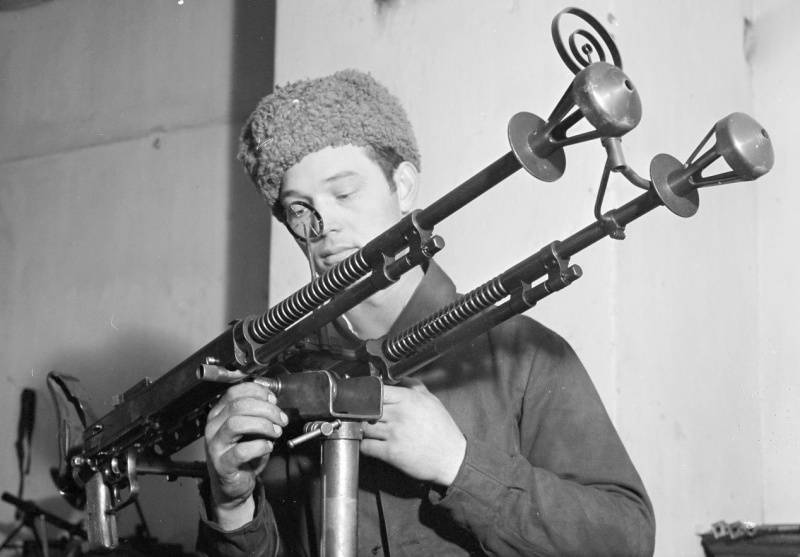
Machine guns were mounted on turrets or the simplest swivels created in former civilian enterprises or in armory workshops in the front line.
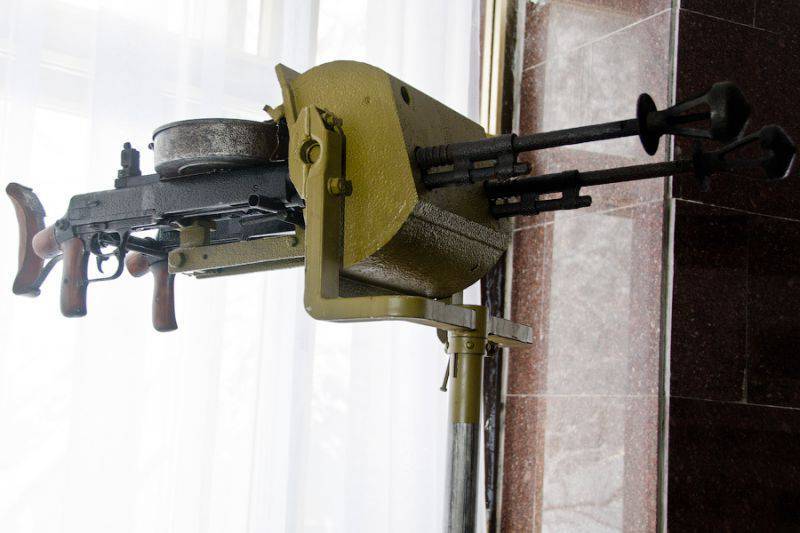
The use of Degtyarev aircraft machine guns was facilitated by the fact that they were initially equipped with sights intended for firing at fast moving air targets.
Since the principle of operation of the automatics YES and YES-2 did not differ from the DP-27 and DT-29, surrogate anti-aircraft installations were quickly mastered by the troops. Machine guns were equipped with a cartridge on the 63 cartridge. A noticeable external difference between the YES and the DT-29 was that instead of the butt, a notched wooden pistol grip and rear grip were installed. On the paired YES-2 there was a shortened shoulder rest. Twin machine guns were equipped with large flame arresters, to prevent blindness of the shooter.
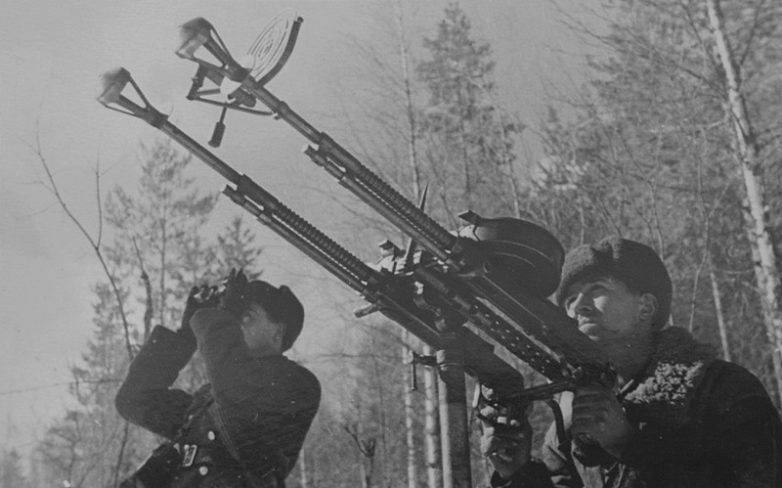
Despite the lack of a uniform standard and the semi-artisan nature of turret production, in general it turned out to be a fairly effective light anti-aircraft weapon with a rate of fire at one barrel of 600 rds / min. A twin installation with two equipped magazines, mounted on a tripod machine, weighed half as much as a Maxim machine gun on an anti-aircraft machine arr. 1928
On the basis of aircraft machine guns PV-1 N.F. Tokarev in August 1941 created a built anti-aircraft gun. This weapon, despite the unsightly appearance, greatly strengthened the army air defense of the Red Army. From the Maxim machine gun, the aviation machine gun was notable for lack of water cooling and a shortened barrel, which made it possible to reduce the mass of weapons. The weight of the PV-1 without cartridge tape was 45 kg. The total rate of fire of the anti-aircraft gun was approximately 2200 rds / min. At the same time, for a much more complex and heavy quadruple M4, this figure was 2400 rds / min. Compared with the SHKAS high-speed machine gun, the more massive PV-1, due to its design features, greater safety margin and a relatively low rate of fire, turned out to be more reliable when operating on the ground. Unlike ShKAS, he easily “digested” lower-quality rifle cartridges used in infantry.
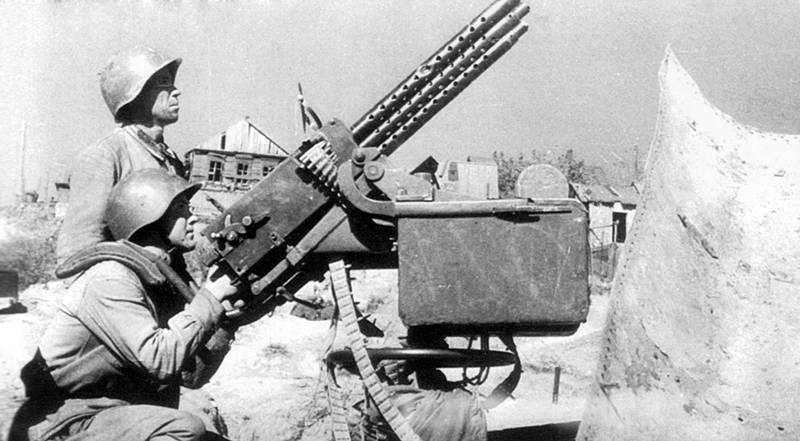
The Tokarev surrogate anti-aircraft installation, created in a short time, with less weight and cost, was almost as effective as a specially designed quad installation. The mass production of anti-aircraft machine guns using the PV-1 began at the end of 1941 in Tambov. Total military 626 adopted such installations. They played a prominent role in the fighting at Stalingrad. As the zenith parts were filled with large-caliber machine guns, 25 and 37-mm anti-aircraft guns, the built-in installations, which remained in a working condition, were transferred to rear anti-aircraft units. Quite a lot of them survived until victory on armored trains.
Soon after the adoption of the ShKAS high-speed aircraft machine gun in 1936, the question arose of creating an anti-aircraft gun at its base. The rate of fire turret ShKAS was 1800 shots / min, and theoretically one rapid-fire machine gun could replace three Maxims. This promised a significant increase in the firepower of the air defense of the ground forces while reducing the mass and dimensions of anti-aircraft installations. In 1938, a technical assignment was issued for the creation of a paired installation of ShKAS machine guns on a light tripod machine, which was supposed to change the production of Maxim's four anti-aircraft machine guns. 1931 and the industry manufactured a small number of paired installations. However, during the field tests, it turned out that, when used on the ground, the SCARC is sensitive to the quality of service. He demanded qualified adjustment, more thorough cleaning and lubrication. And most importantly, in order for the machine gun to fire without delays, special higher-quality ammunition was used in the Air Force. The aviation parts supplied 7,62-mm cartridges with double bullet rolling in the neck of the liner and a more reliable and better insulated primer. Such cartridges were significantly more expensive, and the command of the Red Army refused to create anti-aircraft systems based on ShKAS.
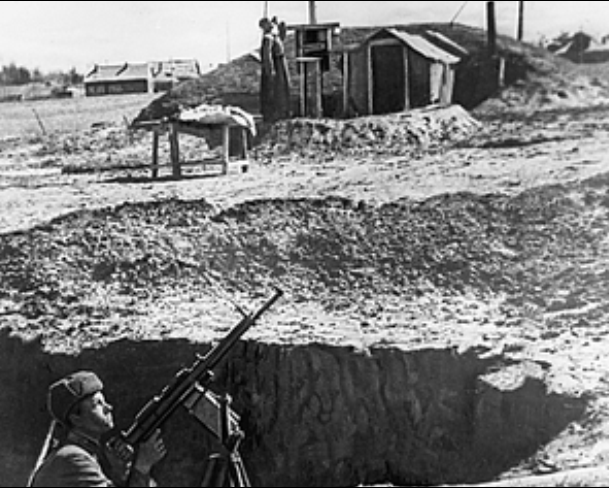
However, after the outbreak of hostilities, the ShKAS machine guns still fired at enemy aircraft from the ground. In the Air Force, high-speed rifle-caliber machine guns in the first half of the war were actively used in the air defense of airfields. In this case, there were no problems with the maintenance of machine guns and the supply of conditioned cartridges.
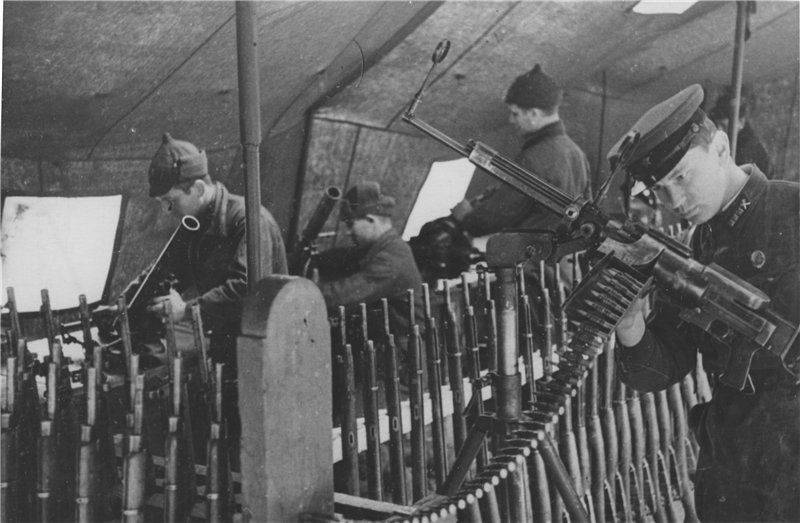
Single and twin ShKAS were mounted on tripod machines made in weapons workshops, providing circular firing and height adjustment. Responsibilities for firing and maintenance of machine-gun systems, as a rule, were assigned to aviation technicians and gunsmiths.
In 1939, the machine gun DS-39 developed by V.А. began to arrive in the army to replace the Maxim machine gun. Degtyarev. Compared with Maxim's machine gun, the new machine gun was much easier. For shooting at aerial targets designer GS Garanin developed an anti-aircraft tripod for the machine gun.
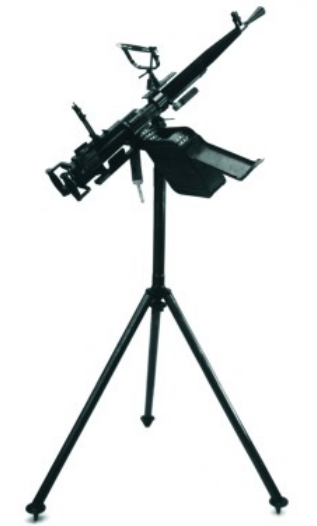
Externally, the DS-39 resembles a large-caliber DShK reduced in size. Compared with the Maxim machine gun, the DS-39 machine gun was much lighter and had air cooling, after intensive firing its barrel could be quickly replaced with a spare one. The machine gun was equipped with a switch rate of fire at ground (600 rds / min) and air targets (1200 rds / min). Before the war, Degtyaryov created a quadruple anti-aircraft installation, which was tested in the back of the "lorry", but it was not mass-produced.
However, with all its merits, the DS-39 could not force out the outdated Maxim machine gun. This is partly the fault of the military itself, who are not ready to abandon the machine-gun machine belts, which ensured unification with the machine guns already in the troops. Initially, Degtyarev designed his heavy machine gun for a metal ribbon, and switching to canvas had a negative effect on the reliability of the automation. In addition, the DS-39 was more sensitive to low temperatures and dustiness. Degtyarev guaranteed that his machine gun could be brought to an acceptable level of operational reliability, but in June 1941, the batch production of DS-39 was stopped and returned to the assembly of Maxim's machine guns.
The Soviet leadership was well aware of the need to replace Maxim machine guns. Although the existing machine guns allowed for the firing of intense fire, they were well mastered and loved by the troops, their excessive weight made it difficult to escort the advancing infantry. While our troops were fighting defensive battles, it was not so critical, but with the transition to offensive operations, all the shortcomings of an outdated easel machine gun appeared to the full.
In 1943, SG-43 designer PM won the competition for a new machine-gun. Goryunova. Unlike Maxim, the new machine gun had a replaceable barrel of air cooling. The machine gun was installed on the Degtyarev wheel machine, or on the Sidorenko-Malinovsky machine. Both options allowed firing at ground and air targets.
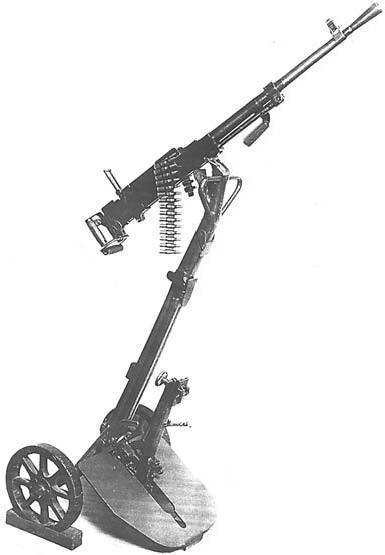
The composition of the machine gun accessories included an anti-aircraft sight aimed at firing at air targets moving at speeds up to 600 km / h at ranges up to 1000 m.
In addition to domestic anti-aircraft machine guns in the Red Army during the war years, foreign samples were used - captured and lend-leased: American 7,62-mm Browning М1919А4, 12,7-mm Browning М2, 7,62 and 7,7-mm British Vickers machine guns, as well as trophies, as well as trophies, as well as trophies and hooks. MG-7,92, MG-13, MG-15 and MG-34.
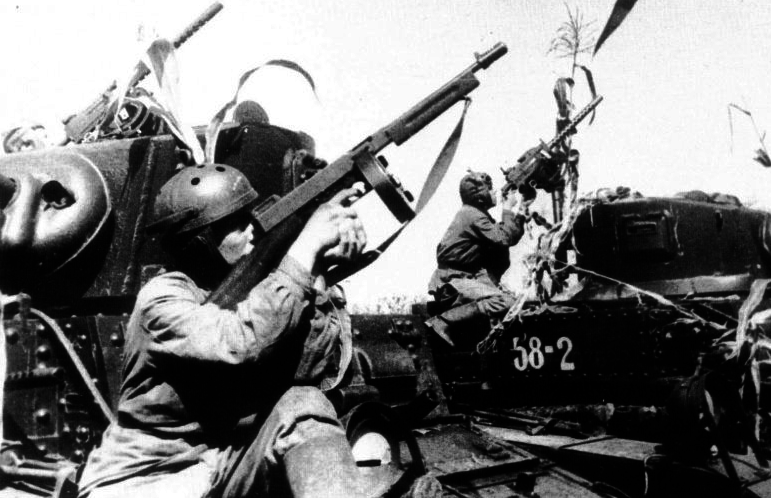
Soviet tank crews on the American light tanks М3А1 from the 75-th separate tank battalion imitate a fire on an aerial target, photo staged
American machine guns designed for firing at air targets were usually mounted on armored vehicles supplied to the USSR or used in navy and air defense airfields. This facilitated the operation and supply of ammunition.
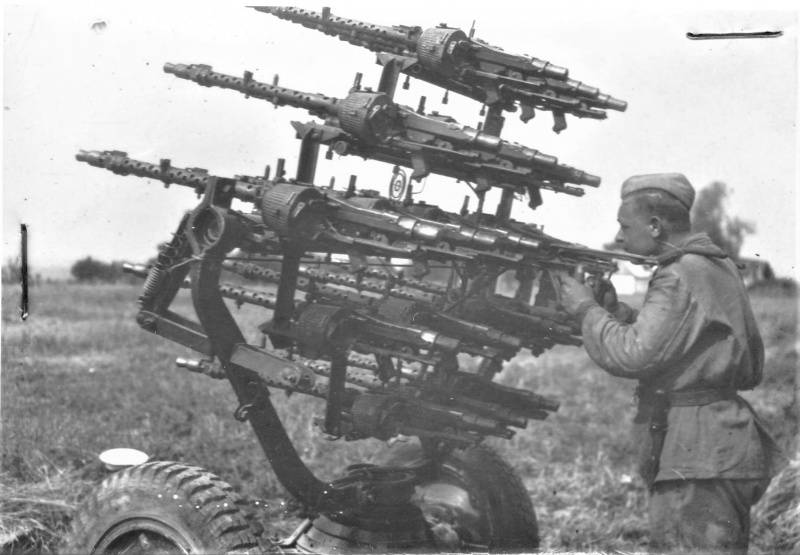
At times among the trophy samples there were very original copies. Most often, captured German MG-34 and MG-42 on anti-aircraft machines installed on trucks that accompanied the transport columns, or used for the protection of stationary objects: warehouses, fuel stores, bridges and airfields.
Many captured German machine guns were used in the armament of anti-aircraft armored trains. Such “armored trains” were created quite simply - open railway platforms were sheathed on both sides to a height of one and a half meters with wooden sleepers that protected anti-aircraft gunners from splinters. Anti-aircraft guns and machine guns were installed on the platforms “armored” in this way. The artillery of an anti-aircraft armored train could be the most diverse: medium-caliber anti-aircraft guns - 76,2-mm or 85-mm, 20, 25 and 37-mm anti-aircraft guns, 12,7-mm machine guns of DShK, as well as various rifle-caliber machine guns. On separate platforms were located ranging posts and anti-aircraft fire control devices. With each platform there was a telephone connection, which transmitted commands and data for anti-aircraft fire. Construction of the first armored trains of the air defense began in Leningrad, where they were called railway batteries.
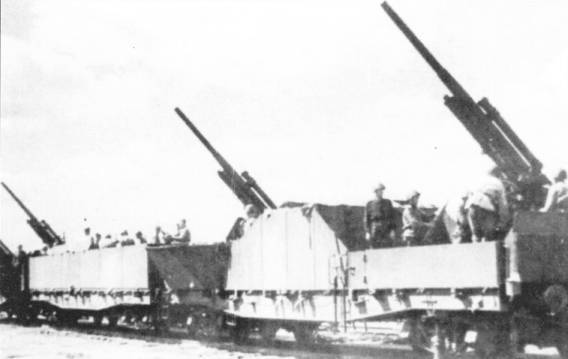
Subsequently, real armored trains with armored cars covered with 7-10 mm anti-bullet armor and anti-aircraft guns mounted in armored top-mounted towers or with splinter shields were created. Compared to the armored platforms, the steam locomotives were more seriously booked: from the board from the pipe to the wheels with armor plates of 25 mm and 15 mm thickness from the roof.
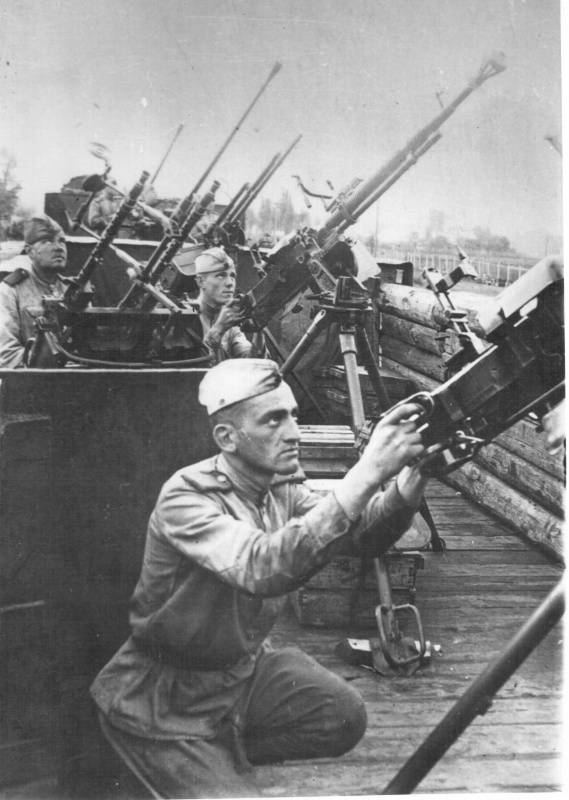
Organizationally, each anti-aircraft armored train included: two crews of locomotive machinists, a platoon of medium-caliber guns, a platoon of control points for artillery-anti-aircraft fire and a rangefinder, two platoons of small-caliber guns and a machine-gun platoon for three or four machine-gun installations, an economic department, a track service and an artillery technical service security. Due to the diverse composition of anti-aircraft armament of an anti-aircraft armored train, they could effectively deal with enemy aircraft operating both at low and medium altitudes. Anti-aircraft armored trains during the war years played an important role in the protection of transport hubs, large bridges, strategically important industrial enterprises and naval bases against air raids.
In the initial period of the war, the low effectiveness of rifle-caliber anti-machine-gun systems against all-metal aircraft was revealed. Already in the 1941, in the Luftwaffe, partially armored fighter-bombers Bf 109E and Bf 110F were used for strikes against ground targets. In 1942, the bodyguard was enhanced on the Hs 123В attack aircraft and the Ju 87D dive bombers. In May, the 1942 of the year appeared on the front armored attack aircraft Hs-129B-1. For their sure defeat, a weapon was needed that could penetrate armor up to 12 mm thick. In addition, 7,62-mm machine guns had a relatively small effective range. In the conditions of an acute shortage of large-caliber DShK machine guns in combat, aviation 12,7-mm machine guns UBT and 20-mm ShVAK guns were used. First of all, this applied to aviation units in which it was possible to dismantle armament from airplanes that are not subject to recovery. If the UBT large-caliber machine guns were used exclusively on artisanal swivels in the air defense of field aerodromes, then anti-aircraft installations based on 20-mm ShVAK cannons were produced in small quantities at industrial enterprises.
Initially, the ShVAK aviation gun was developed for an 12,7-mm cartridge and almost simultaneously with the adoption of an anti-aircraft gun in the Air Force. From 1935 to 1937 year version, intended for the air defense troops, produced in small series.
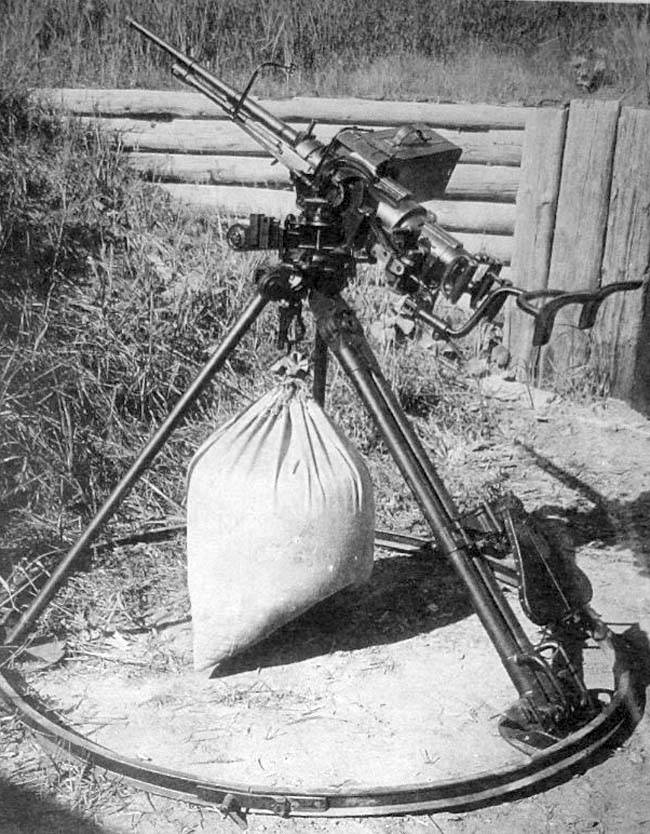
A large-caliber machine gun was mounted on a Kolesnikov wheel or tripod machine or an Ershov naval thumbus anti-aircraft installation. An option was also created on an anti-aircraft stand for installation in the back of a GAZ-AA vehicle. However, after the adoption of a large-caliber machine gun DShK, the production of the anti-aircraft variant ShVAK was turned down.
In the initial period of the war, when the troops experienced an acute shortage of anti-aircraft machine guns, the stock of ShVAK aircraft cannons accumulated in arms factories and aircraft armament warehouses went into action. Of course, the weight and size characteristics of the 20-mm gun, designed for use in aviation, were far from ideal, and its ballistic data and reliability in high dusty conditions left much to be desired, but in conditions of total lack of air defense weapons, it was not so important.
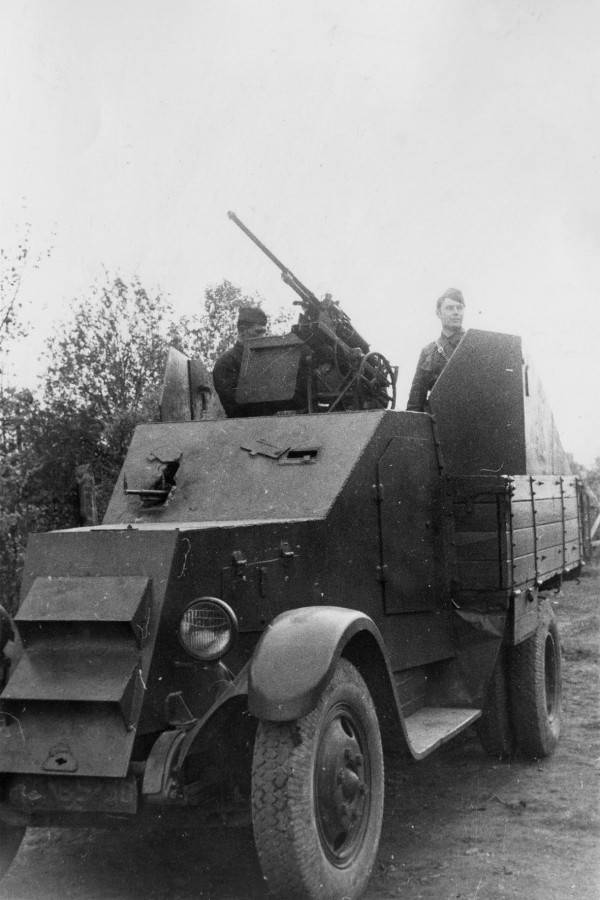
It is reliably known that in the late autumn of 1941, at the Izhora plant in Leningrad, several partially armored ZSU were built on the basis of the ZiS-5 truck. Anti-aircraft installation served by two people. Cab and engine also booked. In the cabin opposite the passenger seat there was a DT-29 machine gun. In the body covered from the sides of the light armor, a 20-mm ShVAK cannon with 250 rounds of ammunition was mounted on a tumba stand.
The exact number of ShVAK anti-aircraft installations built during the war is unknown, since in the USSR 20-mm anti-aircraft guns were not officially accepted for service. Moreover, part of the anti-aircraft guns was converted from aircraft guns, dismantled from decommissioned aircraft.
Most of the ShVAK anti-aircraft guns were freelance operated by the Air Force and were not taken into account anywhere. Domestic 20-mm anti-aircraft guns also armed the armored train, and in the fleet installed mobilized civilian ships, torpedo and patrol boats.
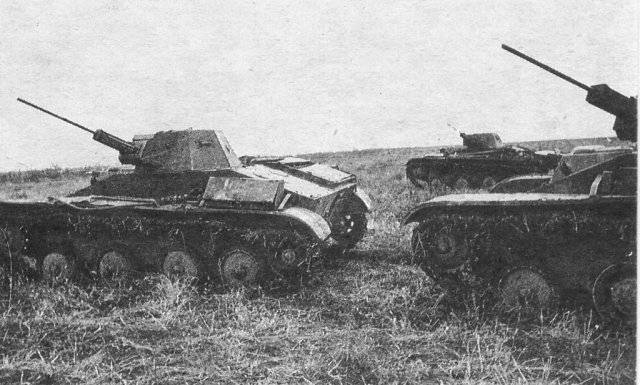
The ShVAK tank variant - the TNSh automatic gun with an extended barrel was mounted on T-60 light tanks. Although the T-60 did not have special anti-aircraft sights with a wide field of view, and the angle of elevation of the gun was just 25 °, light tanks often fired at low-flying aircraft. Although in most cases it was impossible to get on a plane with such anti-aircraft fire, it gave a certain moral effect. Seeing tracer shells flying in their direction, German pilots tended to quickly get rid of the bombs. But sometimes success was accompanied by Soviet tank crews. So, at the beginning of 1942, near Leningrad, a line of 20-mm TNS cannons was shot down by Ju 87. On the basis of light tanks T-60 and T-70 during the war years ZSU were designed, but, unfortunately, they were not mass-produced.
Serial and surrogate anti-aircraft machine gun installations had a significant impact on the course of hostilities, especially in the initial period of the war. At the same time, already in the autumn of 1941, German pilots began to note that the Soviet infantry, caught on the march, often no longer fled in panic, but was met by German dive bombers and attack planes with organized rifle volleys, which affected the growth of the Luftwaffe losses. In some German aviation parts, losses from rifle-and-machine-gun fire in the initial period amounted to 60%. Although on the Messers and Junkers in the frontal part there were bulletproof windows and local booking of the cabin, sometimes one rifle bullet that hit the radiator of a liquid-cooled engine, it was enough for the enemy plane to go for an emergency forced landing.
To reduce losses, the German pilots were forced to increase the height of the bombing, and with a strong rifle and machine-gun fire from the ground, to avoid ground attack using machine-gun and cannon weapons.
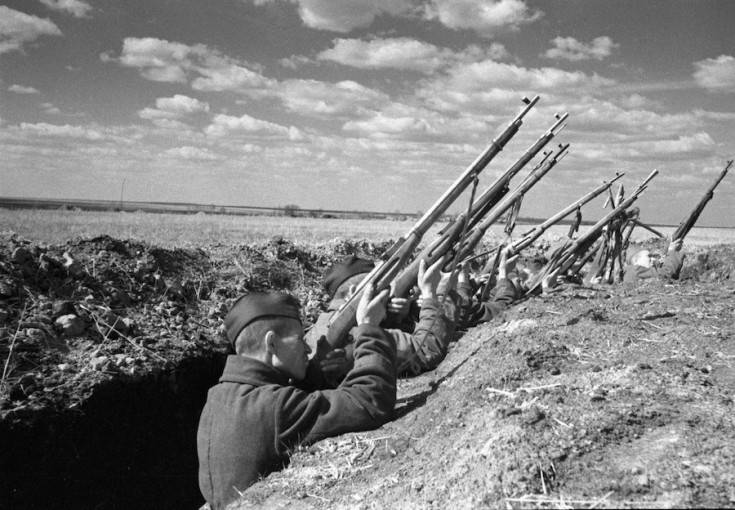
Considering the sad experience of the first months of the war, the weakness of the fighter and anti-aircraft cover, in the infantry units, training began on the skills of firing anti-aircraft fire from personal weapons at low-flying enemy aircraft. I must say that it gave a certain result. Thus, in the first year of the war, according to reports received from the front, 3837 enemy aircraft were shot down. Of these, 295 accounted for anti-aircraft machine gun installations, 268 - for rifle-and-machine-gun fire of troops.
However, the threat to low-flying aircraft was not only fire from rifles and machine guns that were at the disposal of the Soviet infantry. In 1942, the troops began to be actively saturated with submachine guns. In the Soviet PPD-40, PPSH-41 and PPS-43, a very powerful 7,62 × 25 mm cartridge was used with an initial bullet velocity up to 500 m / s. In 1941, a cartridge with an P-41 armor-piercing incendiary bullet entered service. Armor-piercing incendiary bullets were intended for shooting at motorcycles, cars and low-flying aircraft. Under the shell of the P-41 armor piercing incendiary bullet there is a steel armored piercing core with a pointed apex, placed in a lead shirt, and the head of the bullet between the shell and the core is filled with an incendiary composition. And the usual bullets fired from the PPSH-41, at a distance of 100-150 meters, represented a certain threat to the unarmored parts of the aircraft. A pistol bullet with a mass of 5,5 g was quite capable of penetrating the cabin board, not covered with armor, or a plexiglass flashlight.
In 1942, the Soviet military air defense system increased slightly, but the infantry continued to achieve good results in the fight against enemy aircraft. For example, 10-I, 65-I, 92-I and 259-I guards divisions reported on 129 shot down enemy aircraft, and this is only those victories that infantrymen were able to confirm. A significant part of the enemy aircraft managed to shoot down from the 14,5-mm anti-tank guns PTRD-41 and PTRS-41.
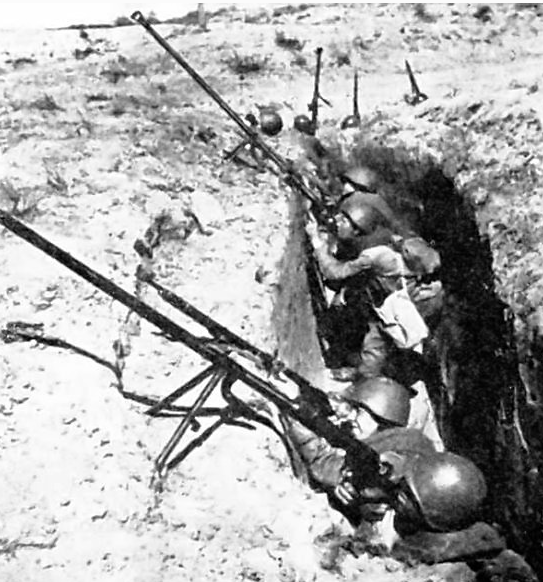
Initially, this weapon was not intended for firing at air targets, but with a creative approach it showed very good results. At a distance of 500 m bullet BS-32 mass 64 g, with steel heat-treated core, leaving the barrel with an initial speed of a little more than 1000 m / s, pierced 22 mm armor. Such characteristics of armor penetration allowed to penetrate guaranteed through a protected tank with fuel or a pilot's cabin covered with light armor.
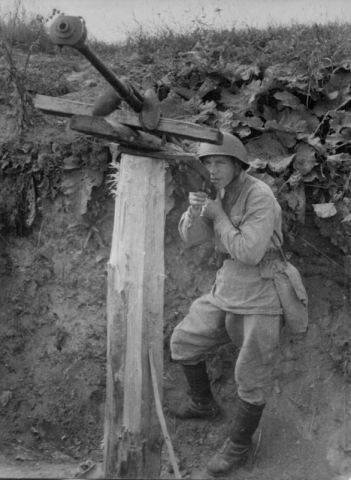
At first, the firing of anti-tank guns at enemy aircraft was carried out spontaneously, and since no one armored was taught how to determine the advance in terms of range and speed of flight, it was not very effective. However, by the beginning of 1942, the use of anti-tank weapons in military air defense began to be organized and, with personnel, armed with anti-tank guns, underwent appropriate training.
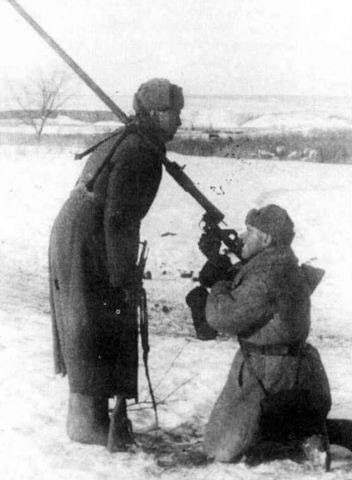
When equipping rifle positions for firing at air targets on the parapet of a trench, a wooden device, like a slingshot, was installed, which served as a stop for the barrel of the MWT. In the field, in the absence of a better support, could be the shoulder of the second calculation number.
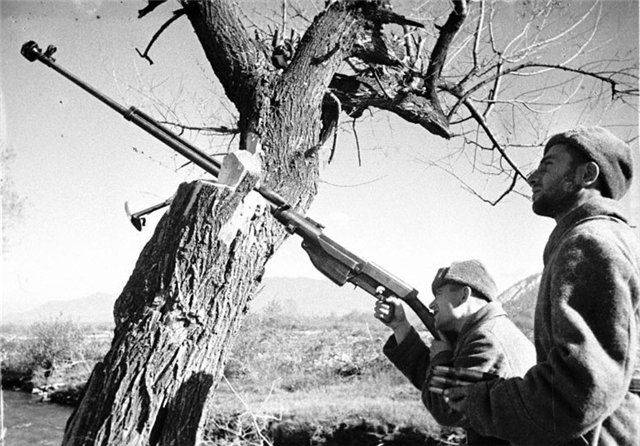
Often for the best emphasis used various improvised improvised designs and forks of tree trunks. During urban battles, low walls and fences served as an emphasis. In some cases, when arranging a position for shooting at airplanes, a cart axle or a pole with a rotating wheel fixed on it was dug into the ground as a stop for the PTR barrel - the rotation of the wheel ensured that the PTR barrel could be quickly moved along the horizontal plane. Often, cells were dug to a depth of up to 1,5 m, which were interconnected by message strokes, under the anti-aircraft positions of the PTR, with the possibility of circular shelling. Such cells defended on the front line duty calculations from the fragments of aerial bombs and shells.
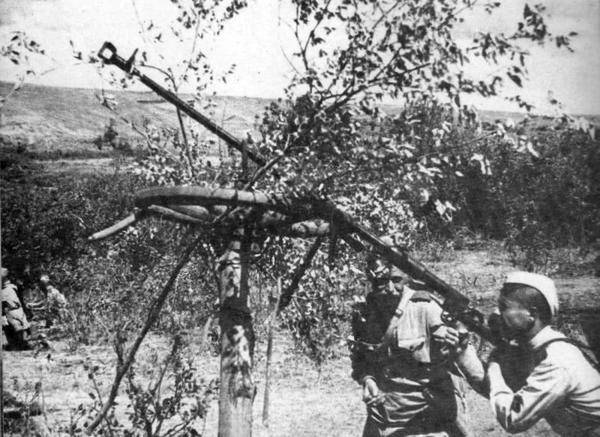
In a number of cases, anti-tank guns were mounted on machine tools of defective or broken anti-aircraft machine guns. But the arrangement of such a position required time and was used, as a rule, in a long-term defense.
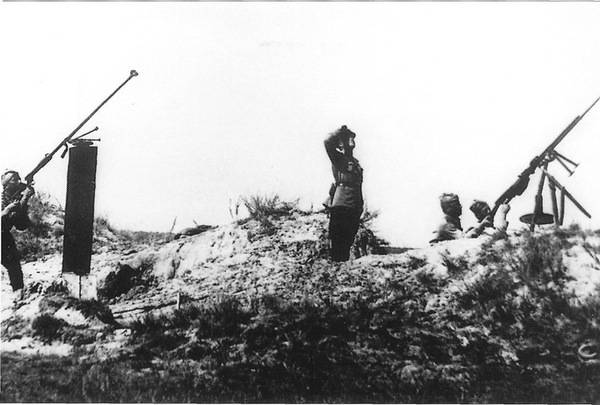
The air defense units in which the anti-aircraft missiles were used were organized to protect battalion and regimental headquarters, medical sanatoriums, artillery and mortar positions and warehouses from air strikes. With a combat rate of fire of 10-15 rounds per minute, the 6-8 PTR on anti-aircraft guns could successfully replace one large-bore DShK machine gun.
A significant contribution to the development of methods of firing from the PTR on aircraft was made by the rifleman-armor-piercer of the 284 th rifle division Dmitry Shumakov. During the Battle of Stalingrad, he drew up schemes and methods for shooting at planes flying at different heights and at different angles relative to the shooter. The developed schemes and memos began to be used by the armored personnel of the 284 Infantry Division, and then other units.
Anti-tank guns significantly exceeded the range of fire and the destructive effect in the case of hitting the target all other types of infantry small arms. Even the heaviest armor of the Hs-14,5 and Fw 129F attack aircraft did not save heavy 190-mm bullets. Noticeable losses from the fire of Soviet MTRs in 1942 were carried by Ju 87 dive bombers.
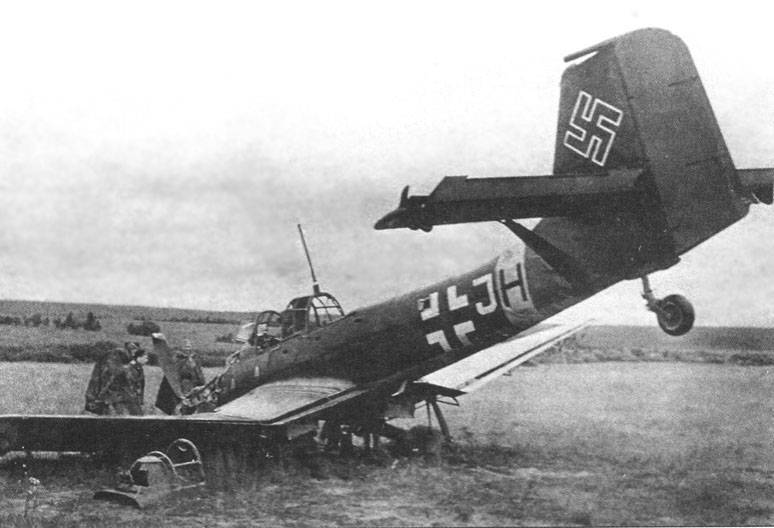
Of the anti-tank guns, they repeatedly succeeded in shooting down Fw 189 scout-spotters, especially hated by our infantry, whose pilots kept the height over 1000 m outside the effective fire zone of rifles.
This is how the military correspondent Lt. P. Kozlov described this episode in the newspaper 236 of the Infantry Division “To the Glory of the Motherland” from 25 of May 1944 of the year:
Taking the lead on the 3 figure, Drozak fired several shots. Haze gaps thermite bullets lay ahead of the Nazi vulture.
Then Drozak took the lead on the smaller 1,5 figure and fired.
The enemy aircraft started slightly and squinted. And after a few seconds, the “frame” began to smoke and, with a burning torch, flew down.
- Hooray! - fighters shouted with joy, - “Focke-Wulf” is burning ...
This example convincingly shows that infantry weapons can successfully repel enemy air raids. It is necessary to comply with the following requirements: to be calm, time to hide in the gap, disguise. And as soon as the plane is reduced, conduct aimed fire at it.
The armored operators Drozak and Lebed received commendation from the unit commander and were presented with government awards. ”
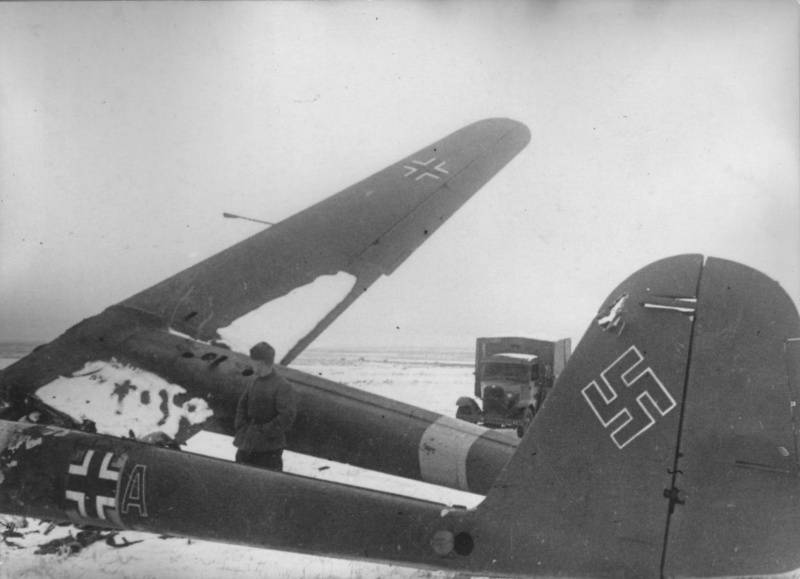
The most effective fire on air targets had a self-loading anti-tank gun of the Simonov system with a magazine for 5 cartridges. When firing at planes, it was recommended to use armor-piercing tracer cartridges, which made it possible to quickly amend the tip of the weapon. Although from 1943, large-caliber anti-aircraft machine guns and high-speed anti-aircraft guns of domestic production and supplied by the allies came to the troops in ever-increasing volumes and were delivered by the allies, the PTR value in the air defense of small infantry units remained until the very end of the war.
Probably the most unusual Soviet surrogate anti-aircraft weapons were anti-aircraft installations, adapted for launching aviation missiles RS-82. 82-mm rockets were used by our aircraft from the first days of the war and proved to be quite good against ground and air targets. In the case of use against ground targets, aviation rockets were completed with percussion weapons (AM-A), while firing at airborne missiles - with a remote fuse (AGDT-A). When preparing the PC-82 with a remote fuse for combat use, the range of detonation of the warhead after launch was pre-set on the ground.
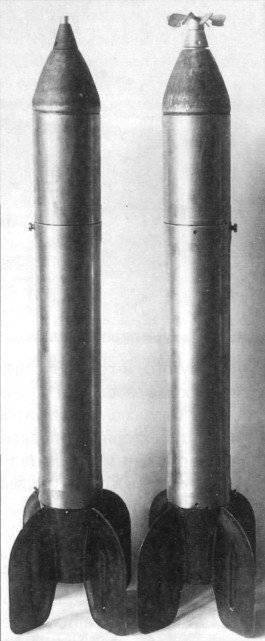
PC-82 with a length of 600 mm weighed 6,8 kg. Fragment warhead contained 360 g of TNT or surrogate explosives based on ammonium nitrate. The jet engine on pyroxylin-trotyl powder consisted of 28 powder checkers with a total mass of 1,1 kg. The maximum speed of a missile without taking into account the speed of the carrier is 340 m / s. The radius of the solid zone of destruction by shrapnel 6-7 m.
In the initial period of the war, the RS-82 was used on all types of Soviet fighters, on Il-2 attack planes, Su-2 and Pe-2 bombers. It was an easy-to-use, inexpensive, and fairly effective weapon when firing at areal targets. In aerial combat, the highest efficiency was achieved with the launch of fragmentation of the PC-82 with a remote fuse on air targets, going in a close closed formation.
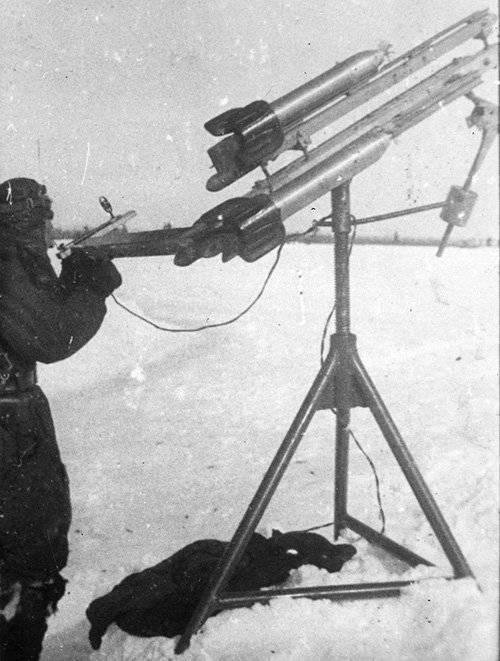
Due to the acute shortage of standard anti-aircraft guns in the fall of 1941, the airfield craftsmen began to create anti-aircraft guns using PC-82 projectiles with a remote fuse with a number of guides from 2 to 24.
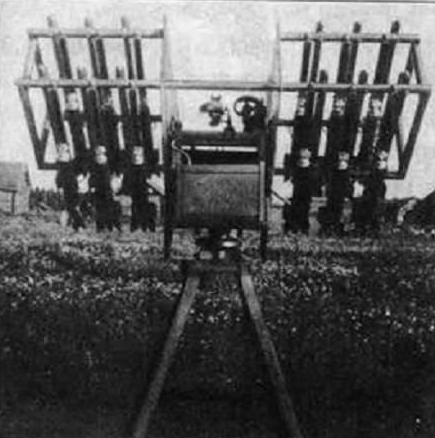
In 1942, the production of anti-aircraft launchers was conducted in the regimental and divisional workshops of the Air Force. In most cases, standard guides with a length of 82 mm, mounted on a welded or riveted frame, with the possibility of circular shelling and changing the angle of elevation, were used to launch the PC-835. Launching rocket projectiles was carried out using electric igniters from a battery or from pyro pistols. The sights were used both mechanically from aircraft turret machine guns, with a ring net and a vane-front sight, and collimator ones. The question of protecting the shooter from hot gases at the launch of the missiles was decided by installing screens, spacing guides and anti-aircraft installation controls, using goggles, a helmet and gloves. The personnel of the maintenance battalion were usually involved in the duty of improvised anti-aircraft missile launchers.
When collecting material for this publication, it was not possible to find reliable documented cases of the defeat of enemy aircraft using ground-based launchers PC-82. However, given that such installations were used quite widely before the summer of 1943, it can be assumed that there were still cases of defeat of German fighters and bombers by antiaircraft PC-82. In general, the combat capabilities of improvised anti-aircraft guns were low, which was primarily due to the characteristics of the missiles. At a distance of 300 m, PC-82 projectile dispersion in the lateral direction was 3 m, and almost 4 m in height. The active part of the trajectory of PC-82 projectiles at the end of which the ammunition accelerated to maximum speed, was within 220 – 280 m (depending on the temperature of the jet engine charge). The relatively straightforward flight path was maintained at a distance of up to 700 m. Given that the projectile flew relatively slowly, and the dispersion was very significant, major problems arose with the choice of the correct aiming point and the moment of opening fire. However, artisanal anti-aircraft missile systems played a certain role in protecting our airfields from air strikes. Having noticed missile launches to their side, the pilots of enemy aircraft, as a rule, stopped the attack and tried to get rid of the bombs as soon as possible. Well-marked breaks in the course also did not add optimism to the crews of German bombers, and on the flight maps appeared marks that the airfield had anti-aircraft cover. Thus, the PC-82 anti-aircraft guns mainly played the role of a kind of “scarecrow” and coped with it very successfully. In the second half of the war, as the number of anti-aircraft guns covering airfields increased, the need for such a peculiar way of using the PC-82 disappeared.
After many years, serious miscalculations made by our military and political leadership on the eve of the war in building the country's air defense and air defense were visible. It is quite obvious that the quadruple machine gun М4, which at first was the main anti-aircraft weapon of the military air defense, was outdated by the beginning of World War II, and the saturation of the troops with very successful large-bore machine guns of the DShK in 1941 was very low. During the war years, the DShK became the main weapon in repelling German dive bombers and attack aircraft. However, the gap between the 12,7-mm machine guns and the 37-mm anti-aircraft guns was virtually filled with nothing. The design of the 25-mm anti-aircraft gun 72-K arr. 1940 g was frankly unsuccessful. In general, he copied the device 37-mm 61-K anti-aircraft guns and also had a charger loading, which adversely affected the combat rate of fire. If such a loading scheme in the 37-mm automatic anti-aircraft gun, which had much larger and heavier projectiles, was justified, then for 25-mm projectiles, tape feed was more suitable. Simply reducing the caliber from 37 to 25-mm did not lead to a corresponding reduction in weight and size. The 72-K anti-aircraft guns were designed for air defense of the regimental level, but were too heavy and cumbersome for this. The rate of fire of the 72-K gun was 240 rds / min, while the 37-mm 61-K gave 170 rds / min. The weight of the 25-mm armor-piercing projectile was 280 g, and the 37-mm projectile - 770 g. Due to the large mass, size and loading-over loading the 25-mm gun was 6-7 guns - the same as the 37-mm Xnum guns -TO.
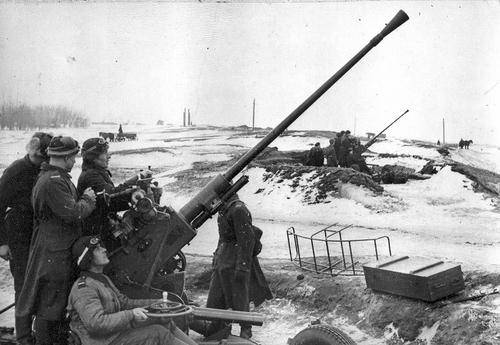
Since the 25-mm gun was mounted on a four-wheel carriage, its weight in the combat position was 1200 kg. French and Japanese 25-mm anti-aircraft guns in the combat position had about half the weight, with comparable range and rate of fire.
As a result, the Soviet 25-mm anti-aircraft guns went completely unnoticed on the background of 12,7-mm machine guns, 37-mm domestic and 40-mm imported anti-aircraft guns. The mass production of 25-mm 72-K guns began in the second half of 1943, when, by and large, there was no longer any need for them. It is completely incomprehensible why during the war years in our country 14,5 and 23-mm rapid-fire anti-aircraft systems with band feed were not created. The resources spent on launching the 25-mm anti-aircraft guns and their projectiles into mass production could be effectively used to create high-speed anti-aircraft guns based on the VYa-23 aircraft gun.
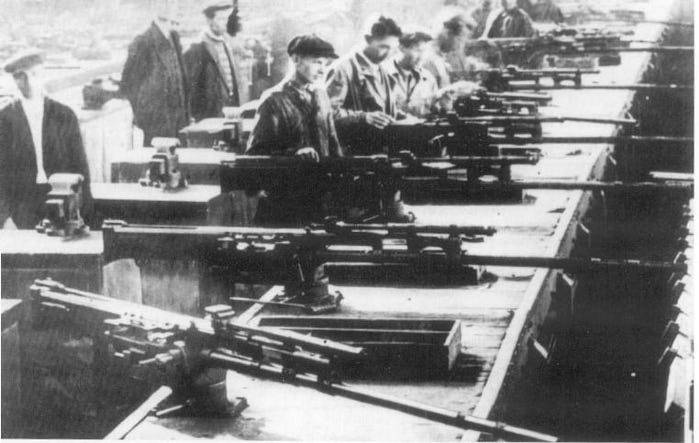
This rather successful aircraft gun, which was used as part of the attack aircraft Il-2 and Il-10, has proven itself in combat. With a weight of 66 kg gun, it had a rate of fire of about 600 shots / min. An armor-piercing incendiary 23-mm projectile with a mass of 198 g, at a distance of 400 meters normal pierced through 25-mm armor. In the case of using a WN-23 as part of an anti-aircraft installation, our military air defense units during the war years could receive weapons comparable in efficiency to the post-war ZU-23 installations. Also, on the basis of VYa-23, it was possible to create an anti-aircraft gun of caliber 14,5-mm chambered for anti-tank guns, which allowed reducing the weight of the weapon itself and increasing the ammunition, while maintaining the effective firing range at the level of the 23-mm projectile. During the war years, the Luftwaffe did not have attack aircraft with armor capable of withstanding hitting 14,5-mm bullets and 23-mm projectiles. Unfortunately, this promising direction of creating effective anti-aircraft installations was realized only in the post-war time.
Based on:
http://topast.ru/strochit-pylemetchik-za-sinii-platochek/
http://forums.airbase.ru/2014/09/t90124--protivotankovoe-ruzhe-kak-sredstvo-pvo.html
https://borianm.livejournal.com/362180.html
http://history.milportal.ru/2012/11/zenitnye-bronepoezda-pvo/
https://coollib.net/b/284572/read
https://forum.warthunder.ru/index.php?/topic/207540-zsu-zis-5-s-pushkoi-shvak-20-mm/
https://pikabu.ru/story/sovetskie_broneboyshchiki_protiv_asov_lyuftvaffe_4040540
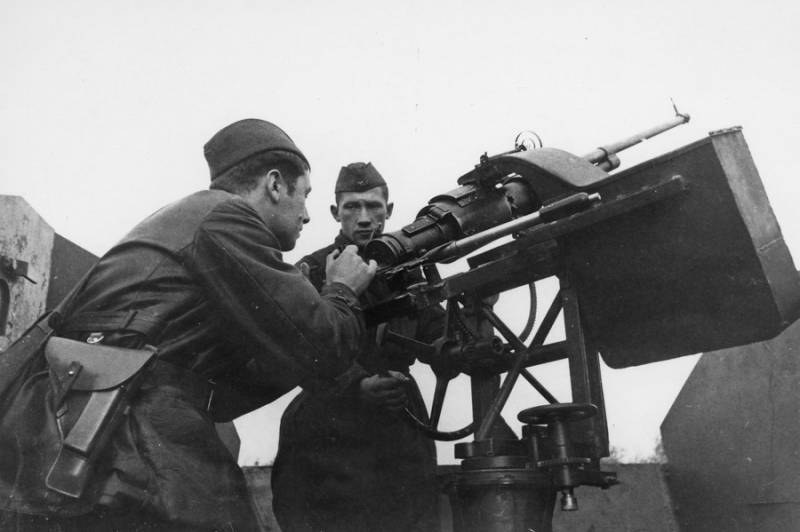
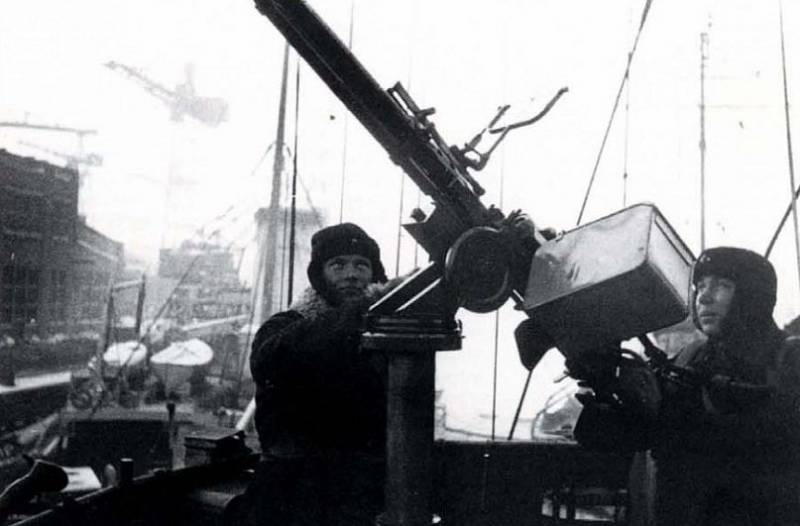
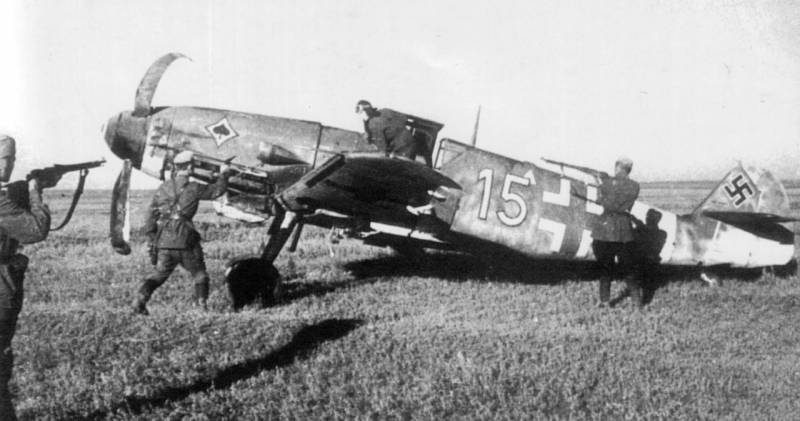
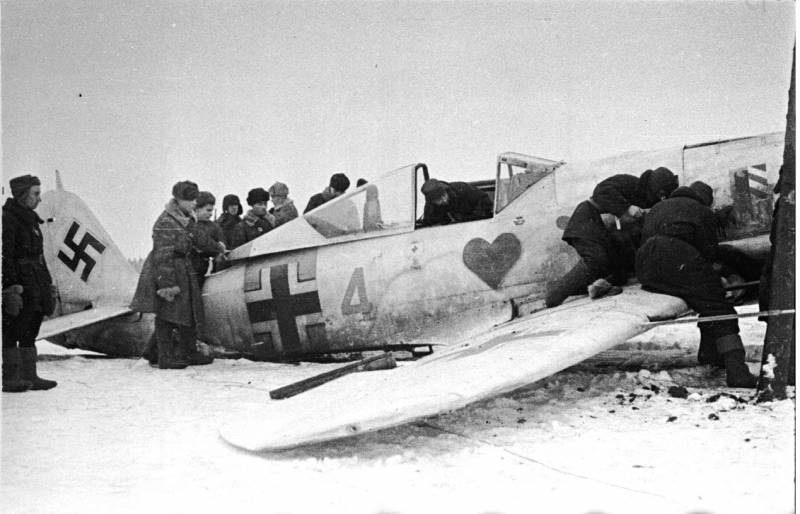
Information